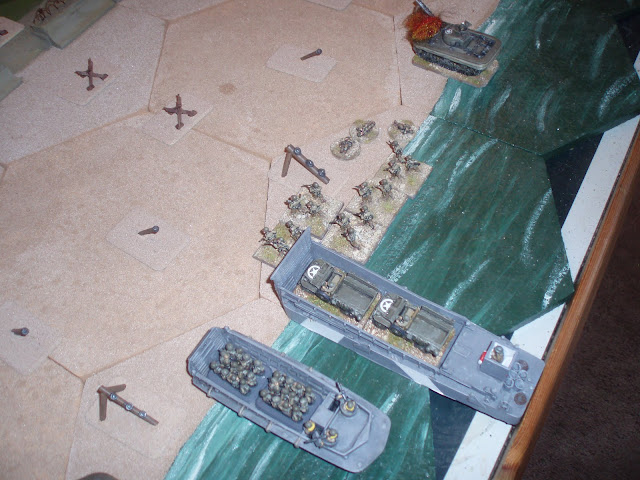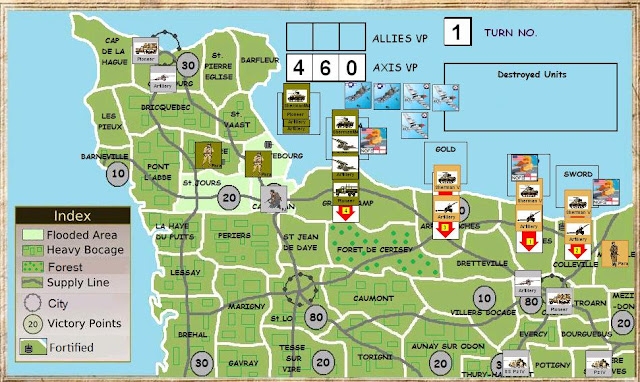The third Firestorm Normandy game was fought this Sunday, and the British had their go at getting a foothold on the Normandy coast, following the successful landings by the Canadians at Juno and last months bloody encounter by US forces on Omaha.
The first picture shows the Queen Red Sector from behind the German positions with WN12 (Sole) in the right foreground, with the Luftwaffe radar post acting as battalion HQ for the third battalion 736 Grenadier Regiment. The hex immediately to the left of this position on the hedge lined road was the key objective for the British force. In the right background immediately on the sea front is the eastern end of WN20 (Cod) which was the strong point for the 10th Company, including a 8.8cm AT gun in the large bunker, 2 x 7.5cm AT guns covering the road off the beach, plus HMGs, Mortars and an artillery OP. In the right background are the houses of Breche de Hermanville which provided cover for a 5cm AT bunker and a tank turret bunker giving support fire to WN20. The position was supported by 15,5cm artillery and reinforcements of infantry and possibly panzers from 21st Panzer Division stationed close by.

The next two pictures show the beach front gun positions interspersed with wire and mines to hold back any troops on the beach to allow them to be dealt with by the machine guns and mortars in WN20


Following the initial bombardment by the navy that managed to knock out an HMG position and a rifle group in the support trenches, the pinning effect of the bombardment allowed the 2nd Battalion East Yorkshire Regiment to take full advantage, by managing to land three platoons in the first wave and rush the sea wall and wire defences.
Because of the possibility of German tanks turning up, the British decided to break in to the defence primarily using their infantry assets bringing on the armour once the anti-tank defences had been neutralised, to help deal with the German infantry. This would help to make sure there were plenty of British tanks around to deal with any German armour.


By turn 3 the British infantry had "bangalored" the sea wall creating multiple breaches allowing them to assault and take out the 8.8cm bunker in the teeth of heavy fire from the German Infantry. The DD tanks and AVRE easily took care of the 5cm and tank turret bunkers, with the infantry and DDs smoking them off, allowing the AVREs to close the range and take them out with their Petard mortars.
 By turn 6 the British infantry was able to make their final assault into COD having taken out most of the German machine gun positions, which with the reduced return fire allowed them to charge into the position and clear it with the grenade and bayonet.
By turn 6 the British infantry was able to make their final assault into COD having taken out most of the German machine gun positions, which with the reduced return fire allowed them to charge into the position and clear it with the grenade and bayonet.
This opened the "flood gates" and the Commandos of 4 Commando stormed across the salt marsh and brought SOLE under fire whilst the Yorks moved into the neighbouring field ready to take the objective.
The Germans were forced to commit their reserves of only half a platoon to try and keep the objective clear of enemy troops, even managing to take out a section of British infantry. By turn 9 the numbers of British troops were overwhelming and the victory was complete.

This time Steve Mathews took the Brits and I the Germans. We both picked up a lot of lessons from the previous games, ie the German infantry firepower is formidable in defence and a combination of mass return firepower and judicious use of smoke when available needs to be used to get in amongst the German troops. This is best done by the infantry who can deal with the AT guns that threaten the armour. The armour is then able to rapidly move inland to get round and behind any remaining resistance.
A really good game, great fun, thanks Steve.
Next game is Gold Beach in 2011















 The Odin Mission by James Holland, the first of the Jack Tanner series. This is the WWII Sharp, which features Sgt Jack Tanner in a mission set during the ill fated Norway campaign in 1940. Really good read, with plenty of historical detail to capture the feel of that campaign. A must for holiday reading.
The Odin Mission by James Holland, the first of the Jack Tanner series. This is the WWII Sharp, which features Sgt Jack Tanner in a mission set during the ill fated Norway campaign in 1940. Really good read, with plenty of historical detail to capture the feel of that campaign. A must for holiday reading. 

 Books focussing on the German Infantry forces in late war Europe at the platoon and company level are very rare, so this book looking in particular at the fusilier battalion of the 272nd Volksgrenadier Division was a great find. The book was able to draw on a unique discovery made after the Berlin wall came down of an old suitcase containing the battalion records of this particular unit that would have been kept by the company clerk. In most cases these records were destroyed at the end of the war, but remarkably these survived to enable a phorensic reconstruction of the personel that were recruited into one of the first Volksgrenadier divisions that was hastily thrown into the fighting in the Hurtgen forest.
Books focussing on the German Infantry forces in late war Europe at the platoon and company level are very rare, so this book looking in particular at the fusilier battalion of the 272nd Volksgrenadier Division was a great find. The book was able to draw on a unique discovery made after the Berlin wall came down of an old suitcase containing the battalion records of this particular unit that would have been kept by the company clerk. In most cases these records were destroyed at the end of the war, but remarkably these survived to enable a phorensic reconstruction of the personel that were recruited into one of the first Volksgrenadier divisions that was hastily thrown into the fighting in the Hurtgen forest. This month gave us a chance to get the sailing ships out and playtest the rules from the Two Fat Lardies, "Kiss me Hardy". The scenario was the free one available on the Yahoo discussion group which pits four British 74s against four French 74s and two 80s. The victory conditions being who could inflict the most damage to the other side. The two forces sailed on to the table in line ahead, with movement, firing, strike tests, boarding attempts and damage checks being carried out in the move as governed by the turn of an appropriate card. I really like the card system as it removes the need to write orders, and events occur in a totally random sequence in each move. The rules are simple to follow without being simplistic, and we picked them up really quickly. We all thought they would make it easy to play with large numbers of ships on the table.
This month gave us a chance to get the sailing ships out and playtest the rules from the Two Fat Lardies, "Kiss me Hardy". The scenario was the free one available on the Yahoo discussion group which pits four British 74s against four French 74s and two 80s. The victory conditions being who could inflict the most damage to the other side. The two forces sailed on to the table in line ahead, with movement, firing, strike tests, boarding attempts and damage checks being carried out in the move as governed by the turn of an appropriate card. I really like the card system as it removes the need to write orders, and events occur in a totally random sequence in each move. The rules are simple to follow without being simplistic, and we picked them up really quickly. We all thought they would make it easy to play with large numbers of ships on the table.















 The Guards attempted to push into the village of Maisoncelles with their tanks supporting the leading platoons, only to come under withering fire from the panzergrenadiers in the hedgerows. The casualties on the Guards started to mount and seeing that the objectives could not be achieved after the losses sustained, the Guards attempted to make an orderly withdrawal, only to fail their morale checks and leave the field in a disordered state. (that's Guards speak for rout).
The Guards attempted to push into the village of Maisoncelles with their tanks supporting the leading platoons, only to come under withering fire from the panzergrenadiers in the hedgerows. The casualties on the Guards started to mount and seeing that the objectives could not be achieved after the losses sustained, the Guards attempted to make an orderly withdrawal, only to fail their morale checks and leave the field in a disordered state. (that's Guards speak for rout).







